Univ. of Illinois, Urbana-Champaign
Bio/Neuro 303
Chapter 6 - Study Questions
160. At chemical synapses, the electrical currents generated by the action
potential in the pre-synaptic terminal have little effect on the
post-synaptic cell because
a. the release of transmitter substance short-circuits the current.
b. the post-synaptic membrane is totally impermeable to all charged
particles at that time.
c. the low resistance of the extra-cellular fluid combined with the
relatively high resistance of the post-synaptic membrane means that
little current enters the post-synaptic cell.
d. the current is literally carried by the transmitter substance.
161. Electrical excitatory transmission requires a
a. large membrane potential.
b. stimulating device.
c. low resistance pathway from pre- to postsynaptic cell.
d. active transport of ions from one neuron to another.
162. At a typical ELECTRICAL synapse, calcium
a. is necessary to maintain proper ion balance in the pre- and
post-synaptic terminals.
b. plays no direct role in transmission.
c. is necessary for transmission.
d. is the transmitter substance.
163. Electrical synaptic transmission is only possible where there is
a. a low resistance route from the presynaptic to the postsynaptic neuron.
b. a lack of external calcium, to suppress chemical transmission.
c. a lack of sufficient synaptic transmitter substance for chemical
transmission to work.
d. a high enough resistance in the external medium so that ion currents
are forced through the membrane of the presynaptic neuron.
164. The fusion between the pre- and postsynaptic membranes in an electrical
synapse is necessary to
a. speed up the action of the transmitter substance on the postsynaptic
cell.
b. produce a low-resistance pathway for current from the presynaptic to
the postsynaptic cell.
c. allow calcium ions to move directly from the postsynaptic cell to the
presynaptic one.
d. make sure that potassium moves directly from the presynaptic cell to
the postsynaptic one.
165. The order of events in chemical synaptic transmission is (AP = action
potential)
a. AP --> release of transmitter --> influx of Ca2+ --> post-synaptic
effect --> inactivation.
b. AP --> influx of Ca2+ --> release of transmitter --> post-synaptic
effect --> inactivation.
c. Release of transmitter --> post-synaptic effect --> influx of Ca2+ -->
AP --> inactivation.
d. Release of transmitter --> post-synaptic effects --> inactivation -->
influx of Ca2+ --> AP.
166. During chemical synaptic transmission, which of the following sequences of
events occurs in a presynaptic neuron?
a. Depolarization of the terminal --> Ca2+ entry --> AP in axon -->
vesicle fusion --> transmitter release.
b. AP in axon --> Ca2+ entry --> depolarization of the terminal -->
vesicle fusion --> transmitter release.
c. AP in axon --> depolarization of the terminal --> Ca2+ entry -->
vesicle fusion --> transmitter release.
d. Ca2+ entry --> AP in axon --> depolarization of the terminal -->
vesicle fusion --> transmitter release.
167. When ligand-gated ion channels open, ions move through these channels
under the influence of the
a. electrical field of the membrane potential only.
b. concentration gradients of the ions only.
c. combined influence of the electrical field of the membrane potential
and the concentration gradients of the ions.
d. metabolic pumps for the moving ions.
168. In the study of synapses, the reversal potential is the imposed membrane
potential
a. of a postsynaptic cell at which the postsynaptic potential disappears.
b. of a presynaptic cell at which the action potential is no longer
capable of triggering transmitter release.
c. at which the conductance of a voltage-dependent channel reverses sign.
d. at which the conductance of a ligand-gated channel reverses sign.
169. The nicotinic acetylcholine (ACh) receptor binds ______ molecules of ACh
and consists of ______ subunits.
a. two; five
b. five; two
c. one; four
d. two; four
170. The post-synaptic effects of a transmitter substance are due to
a. the characteristics of the receptor site with which it binds and the
ion channel(s) they cause to open.
b. the chemical identity of the substance (i.e., catecholamine, peptide,
etc.).
c. the types of ions with which it interacts.
d. none of the above.
171. Binding between a transmitter substance and a receptor molecule
a. requires ATP.
b. can take place only in the presence of calcium ions.
c. is a temporary association that breaks spontaneously.
d. is a true chemical reaction that yields energy in the form of heat.
172. Acetylcholine can be both an inhibitory and an excitatory transmitter
because
a. it is an unusually powerful substance.
b. it is the only transmitter inactivated by enzymatic breakdown.
c. it has a dual action at certain molluscan synapses.
d. the effect of a transmitter is due to properties of the postsynaptic
membrane on which it impinges, not the properties of the chemical
substance itself.
173. One difference between the membrane of an axon and that at the synapse of a
post-synaptic cell is that
a. conductance through ion channels in the axonal membrane is
independent of the membrane potential.
b. conductance through ion channels in the post-synaptic membrane is
independent of the membrane potential.
c. the axonal membrane has no channels for the passage ions.
d. the post-synaptic membrane has no channels for the passage of ions.
174. Ion channels that open to allow the passage of Na+ may be present in the
subsynaptic membrane at an excitatory synapse and in axonal membrane. The
channels at these two locations are similar in that they both
a. allow the passage only of sodium ions when they are open; no other ions
may pass through.
b. open by means of a conformational change in one or more parts of the
channel protein.
c. are voltage sensitive.
d. are associated with a receptor protein that triggers opening.
175. Ion channels that allow the passage of Na+ (and perhaps other ions) may be
present in the postsynaptic membrane at an excitatory synapse and in axonal
membrane. The channels at these two locations are different in that
a. one only allows the passage of Na+ from the inside of the cell to the
outside whereas the other does the reverse.
b. one opens via a conformational change in the structure of the channel,
whereas the other opens a separate gate in a nearby protein.
c. one is voltage sensitive whereas the other is ligand sensitive.
d. nothing. The channels have no important differences.
176. When ligand-gated ion channels open, ions move through these channels
under the influence of the
a. electrical field of the membrane potential only.
b. concentration gradients of the ions only.
c. combined influence of the electrical field of the membrane potential
and the concentration gradients of the ions.
d. metabolic pumps for the moving ions.
177. In many inhibitory synapses the peak of the IPSP tends toward
a. ENa+.
b. ENa+ + EK+.
c. EK+.
d. ECa2+.
178. One way by which a neurotransmitter could act to inhibit a
postsynaptic cell is by causing a(n)
a. increase in Na+ conductance.
b. decrease in K+ conductance.
c. decrease in Cl- conductance.
d. increase in K+ conductance.
179. An ipsp (inhibitory post-synaptic potential) always has the effect of
a. preventing an action potential completely.
b. making it harder to generate an action potential.
c. making it easier to generate an action potential.
d. eliciting an action potential.
180. The person(s) largely responsible for describing the basic physiology of
central synapses was (were)
a. Ochs.
b. Golgi.
c. Katz & Miledi.
d. Eccles.
181. In the study of synapses, the reversal potential is the potential
a. imposed across the membrane of the postsynaptic cell at which the
postsynaptic potential disappears.
b. of the presynaptic cell membrane at which the action potential is
"reversed" during presynaptic inhibition.
c. at which ion conductance is reversed from high to low during synaptic
action.
d. at which conductance is reversed from low to high during synaptic
action.
182. In most excitatory synapses, the peak of the EPSP tends toward
a. ENa+.
b. ENa+ EK+.
c. EK+.
d. ECa2+.
183. The ionic basis for an EPSP is usually the opening of
a. Na+ channels alone.
b. K+ or Cl- channels alone.
c. channels that allow both Na+ and K+ to flow through it.
d. Na+ channels first, followed by K+ channels.
184. When ion channels at a synapse open due to the action of a
neurotransmitter, ions move through these channels under the influence of
the
a. electrical field of the membrane potential only.
b. concentration gradients of the ions only.
c. combined influence of the electrical field of the membrane potential
and the concentration gradients of the ions.
d. metabolic pumps for the moving ions.
185. Excitatory synapses have been described in which the effect of the
transmitter is to
a. increase K+ conductance.
b. increase Cl- conductance.
c. decrease Na+ conductance.
d. decrease K+ conductance.
186. One way by which a neurotransmitter could act to excite a cell is by
causing a(n)
a. increase in K+ conductance.
b. increase in Na+ conductance.
c. decrease in Na+ conductance.
d. increase in Cl- conductance.
187. Inhibitory neurons that synapse directly on the cell(s) they inhibit
a. act to reduce the size of the action potential generated in the
postsynaptic cell.
b. allow for selective inhibition of only some inputs to a cell.
c. do both a and b.
d. do neither a nor b.
188. Functionally, neural inhibition acts to
a. reduce the probability that an action potential will be generated in
the post-synaptic cell.
b. reduce the size of the action potential generated in the post-synaptic
cell.
c. block all excitatory transmission to the post-synaptic cell.
d. shut off calcium ion influx so as to reduce the amount of transmitter
substance released from the pre-synaptic terminals.
189. Neural inhibition acts to
a. reduce the probability that an action potential will be generated in
the postsynaptic cell.
b. reduce the amplitude of the action potential in the postsynaptic cell.
c. reduce the ion concentration gradients across the postsynaptic cell
membrane.
d. increase the duration of the refractory period in the postsynaptic
cell.
190. The ionic basis for an IPSP is usually the opening of
a. Na+ channels alone.
b. K+ or Cl- channels alone.
c. Na+ and K+ channels simultaneously.
d. Na+ channels first, followed by K+ channels.
191. In an inhibitory synapse at which the channel for K+ is the main ion
channel opened, the most important parameter (of those listed below)
influencing the effectiveness of inhibition will be the equilibrium
potential for
a. K+.
b. Na+.
c. Ca2+.
d. Cl-.
192. IPSPs can be effective in reducing the probability that an EPSP will
generate an action potential because
a. the efflux of potassium ions interferes with the influx of sodium ions.
b. the open channels for sodium act as a current source.
c. the efflux of potassium ions and the consequent shift in membrane
potential interferes with the subsequent opening of sodium channels.
d. the open channels for potassium act as a current sink.
193. Which of the following ionic mechanisms has not been described at an
inhibitory synapse?
a. Increase in GK+.
b. Increase in GNa+.
c. Increase in GCl-.
d. Decrease in GNa+.
194. One way by which a neurotransmitter could act to inhibit a cell is by
causing a(n)
a. increase in Na+ conductance.
b. increase in K+ conductance.
c. decrease in K+ conductance.
d. decrease in Cl- conductance.
195. Presynaptic inhibition apparently works by
a. reducing the amount of transmitter released by the excitatory terminal.
b. blocking the effect of the excitatory transmitter on the post-synaptic
membrane.
c. binding calcium in the post-synaptic terminal.
d. breaking down the excitatory transmitter before it has a chance to act.
196. Which of the following configurations best represents pre-synaptic
inhibition? (I = inhibitory junction; E = excitatory junction.)
a. 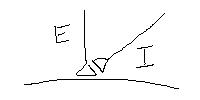 b.
b. 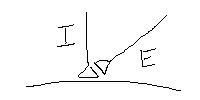 c.
c. 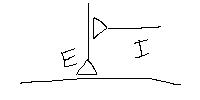 d.
d. 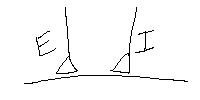 197. Presynaptic inhibition is
a. the pre-inhibition of a postsynaptic cell by influx of Cl- or efflux of
K+.
b. the basis of heterosynaptic facilitation, working by inhibition of
inhibitory neurons.
c. a reduction by an inhibitory neuron of the amount of transmitter
released by an excitatory neuron.
d. chelation of Ca2+.
198. Consider the accompanying diagram of an excitatory synapse subject to
pre-synaptic inhibition. During successful inhibition of cell 3 by the
action of cell 1, the post-synaptic response recorded in cell 3 is
197. Presynaptic inhibition is
a. the pre-inhibition of a postsynaptic cell by influx of Cl- or efflux of
K+.
b. the basis of heterosynaptic facilitation, working by inhibition of
inhibitory neurons.
c. a reduction by an inhibitory neuron of the amount of transmitter
released by an excitatory neuron.
d. chelation of Ca2+.
198. Consider the accompanying diagram of an excitatory synapse subject to
pre-synaptic inhibition. During successful inhibition of cell 3 by the
action of cell 1, the post-synaptic response recorded in cell 3 is
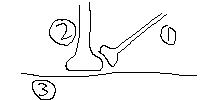 a. a full strength IPSP.
b. a full strength EPSP.
c. a reduced strength EPSP.
d. nothing -- the response in cell 3 is entirely suppressed by the action
of cell 1.
199. Consider again the above diagram of a typical synapse subject to pre-
synaptic inhibition. Cell 2 normally (in the absence of inhibition)
has a(n) ______ effect on cell 3.
a. a full strength IPSP.
b. a full strength EPSP.
c. a reduced strength EPSP.
d. nothing -- the response in cell 3 is entirely suppressed by the action
of cell 1.
199. Consider again the above diagram of a typical synapse subject to pre-
synaptic inhibition. Cell 2 normally (in the absence of inhibition)
has a(n) ______ effect on cell 3.  a. excitatory
b. inhibitory
c. dual inhibitory
d. dual excitatory-inhibitory
200. Which of the following is NOT considered a general characteristic of
neuromodulators?
a. They often exert their effects by entering the postsynaptic cell and
activating a second messenger pathway.
b. G proteins are often involved in generating their effects.
c. Their action tends to be long lasting.
d. They can lead to changes in channel conductances in the postsynaptic
neuron.
201. G proteins are activated by
a. cyclic AMP or cyclic GMP.
b. an influx of Ca2+ ions.
c. phosphorylation by protein kinases.
d. membrane-bound receptor proteins.
202. Some neurotransmitters are thought to act as neuromodulators. A
neuromodulator is a substance whose main post-synaptic effect is generally
a. electrical, with a fast time course.
b. to effect the transfer of action potentials from pre- to post-synaptic cell.
c. one of regulating or modulating the activity of the post-synaptic cell.
d. inhibitory, since inhibition has such a strong influence on subsequent
events.
203. Which of the following is NOT considered a general characteristic of
neuromodulators?
a. Second messengers (such as cAMP) are involved in generating their
effects.
b. Their action tends to be slow and weak.
c. They produce changes in the neuron's electrical characteristics or in
its metabolism.
d. They exert their effects by entering the cell.
204. Neuromodulators are sometimes apparently co-transmitters with other,
traditional transmitter substances. Substances that play this role are
often
a. amino acids.
b. monoamines, but not catecholamines.
c. catecholamines.
d. peptides.
205. Second messengers such as cAMP are typically involved in the action of
a. classical excitatory transmitters such as ACh.
b. excitatory neuromodulators such as serotonin.
c. postsynaptic inhibitory transmitters such as GABA.
d. presynaptic inhibitory transmitters such as GABA.
206. A G protein is activated by
a. cyclic AMP or cyclic GMP.
b. a membrane-bound receptor protein.
c. the influx of Ca2+ ions.
d. a protein kinase.
207. G proteins are
a. intracellular proteins that act as second messengers in neurons by
directly promoting phosphorylation of other proteins.
b. membrane proteins that often act as intermediaries between a membrane
receptor and the production of a second messenger inside a neuron.
c. newly discovered proteins that are important in the generation of an
action potential.
d. newly discovered proteins that are important in the generation of some
postsynaptic potentials.
208. Neural modulation frequently works via second messengers that activate
_____-dependent kinases to phosphorylate a protein.
a. G protein
b. ion channel
c. cAMP
d. voltage
a. excitatory
b. inhibitory
c. dual inhibitory
d. dual excitatory-inhibitory
200. Which of the following is NOT considered a general characteristic of
neuromodulators?
a. They often exert their effects by entering the postsynaptic cell and
activating a second messenger pathway.
b. G proteins are often involved in generating their effects.
c. Their action tends to be long lasting.
d. They can lead to changes in channel conductances in the postsynaptic
neuron.
201. G proteins are activated by
a. cyclic AMP or cyclic GMP.
b. an influx of Ca2+ ions.
c. phosphorylation by protein kinases.
d. membrane-bound receptor proteins.
202. Some neurotransmitters are thought to act as neuromodulators. A
neuromodulator is a substance whose main post-synaptic effect is generally
a. electrical, with a fast time course.
b. to effect the transfer of action potentials from pre- to post-synaptic cell.
c. one of regulating or modulating the activity of the post-synaptic cell.
d. inhibitory, since inhibition has such a strong influence on subsequent
events.
203. Which of the following is NOT considered a general characteristic of
neuromodulators?
a. Second messengers (such as cAMP) are involved in generating their
effects.
b. Their action tends to be slow and weak.
c. They produce changes in the neuron's electrical characteristics or in
its metabolism.
d. They exert their effects by entering the cell.
204. Neuromodulators are sometimes apparently co-transmitters with other,
traditional transmitter substances. Substances that play this role are
often
a. amino acids.
b. monoamines, but not catecholamines.
c. catecholamines.
d. peptides.
205. Second messengers such as cAMP are typically involved in the action of
a. classical excitatory transmitters such as ACh.
b. excitatory neuromodulators such as serotonin.
c. postsynaptic inhibitory transmitters such as GABA.
d. presynaptic inhibitory transmitters such as GABA.
206. A G protein is activated by
a. cyclic AMP or cyclic GMP.
b. a membrane-bound receptor protein.
c. the influx of Ca2+ ions.
d. a protein kinase.
207. G proteins are
a. intracellular proteins that act as second messengers in neurons by
directly promoting phosphorylation of other proteins.
b. membrane proteins that often act as intermediaries between a membrane
receptor and the production of a second messenger inside a neuron.
c. newly discovered proteins that are important in the generation of an
action potential.
d. newly discovered proteins that are important in the generation of some
postsynaptic potentials.
208. Neural modulation frequently works via second messengers that activate
_____-dependent kinases to phosphorylate a protein.
a. G protein
b. ion channel
c. cAMP
d. voltage
 b.
b.  c.
c.  d.
d.  197. Presynaptic inhibition is
a. the pre-inhibition of a postsynaptic cell by influx of Cl- or efflux of
K+.
b. the basis of heterosynaptic facilitation, working by inhibition of
inhibitory neurons.
c. a reduction by an inhibitory neuron of the amount of transmitter
released by an excitatory neuron.
d. chelation of Ca2+.
198. Consider the accompanying diagram of an excitatory synapse subject to
pre-synaptic inhibition. During successful inhibition of cell 3 by the
action of cell 1, the post-synaptic response recorded in cell 3 is
197. Presynaptic inhibition is
a. the pre-inhibition of a postsynaptic cell by influx of Cl- or efflux of
K+.
b. the basis of heterosynaptic facilitation, working by inhibition of
inhibitory neurons.
c. a reduction by an inhibitory neuron of the amount of transmitter
released by an excitatory neuron.
d. chelation of Ca2+.
198. Consider the accompanying diagram of an excitatory synapse subject to
pre-synaptic inhibition. During successful inhibition of cell 3 by the
action of cell 1, the post-synaptic response recorded in cell 3 is
 a. a full strength IPSP.
b. a full strength EPSP.
c. a reduced strength EPSP.
d. nothing -- the response in cell 3 is entirely suppressed by the action
of cell 1.
199. Consider again the above diagram of a typical synapse subject to pre-
synaptic inhibition. Cell 2 normally (in the absence of inhibition)
has a(n) ______ effect on cell 3.
a. a full strength IPSP.
b. a full strength EPSP.
c. a reduced strength EPSP.
d. nothing -- the response in cell 3 is entirely suppressed by the action
of cell 1.
199. Consider again the above diagram of a typical synapse subject to pre-
synaptic inhibition. Cell 2 normally (in the absence of inhibition)
has a(n) ______ effect on cell 3.  a. excitatory
b. inhibitory
c. dual inhibitory
d. dual excitatory-inhibitory
200. Which of the following is NOT considered a general characteristic of
neuromodulators?
a. They often exert their effects by entering the postsynaptic cell and
activating a second messenger pathway.
b. G proteins are often involved in generating their effects.
c. Their action tends to be long lasting.
d. They can lead to changes in channel conductances in the postsynaptic
neuron.
201. G proteins are activated by
a. cyclic AMP or cyclic GMP.
b. an influx of Ca2+ ions.
c. phosphorylation by protein kinases.
d. membrane-bound receptor proteins.
202. Some neurotransmitters are thought to act as neuromodulators. A
neuromodulator is a substance whose main post-synaptic effect is generally
a. electrical, with a fast time course.
b. to effect the transfer of action potentials from pre- to post-synaptic cell.
c. one of regulating or modulating the activity of the post-synaptic cell.
d. inhibitory, since inhibition has such a strong influence on subsequent
events.
203. Which of the following is NOT considered a general characteristic of
neuromodulators?
a. Second messengers (such as cAMP) are involved in generating their
effects.
b. Their action tends to be slow and weak.
c. They produce changes in the neuron's electrical characteristics or in
its metabolism.
d. They exert their effects by entering the cell.
204. Neuromodulators are sometimes apparently co-transmitters with other,
traditional transmitter substances. Substances that play this role are
often
a. amino acids.
b. monoamines, but not catecholamines.
c. catecholamines.
d. peptides.
205. Second messengers such as cAMP are typically involved in the action of
a. classical excitatory transmitters such as ACh.
b. excitatory neuromodulators such as serotonin.
c. postsynaptic inhibitory transmitters such as GABA.
d. presynaptic inhibitory transmitters such as GABA.
206. A G protein is activated by
a. cyclic AMP or cyclic GMP.
b. a membrane-bound receptor protein.
c. the influx of Ca2+ ions.
d. a protein kinase.
207. G proteins are
a. intracellular proteins that act as second messengers in neurons by
directly promoting phosphorylation of other proteins.
b. membrane proteins that often act as intermediaries between a membrane
receptor and the production of a second messenger inside a neuron.
c. newly discovered proteins that are important in the generation of an
action potential.
d. newly discovered proteins that are important in the generation of some
postsynaptic potentials.
208. Neural modulation frequently works via second messengers that activate
_____-dependent kinases to phosphorylate a protein.
a. G protein
b. ion channel
c. cAMP
d. voltage
a. excitatory
b. inhibitory
c. dual inhibitory
d. dual excitatory-inhibitory
200. Which of the following is NOT considered a general characteristic of
neuromodulators?
a. They often exert their effects by entering the postsynaptic cell and
activating a second messenger pathway.
b. G proteins are often involved in generating their effects.
c. Their action tends to be long lasting.
d. They can lead to changes in channel conductances in the postsynaptic
neuron.
201. G proteins are activated by
a. cyclic AMP or cyclic GMP.
b. an influx of Ca2+ ions.
c. phosphorylation by protein kinases.
d. membrane-bound receptor proteins.
202. Some neurotransmitters are thought to act as neuromodulators. A
neuromodulator is a substance whose main post-synaptic effect is generally
a. electrical, with a fast time course.
b. to effect the transfer of action potentials from pre- to post-synaptic cell.
c. one of regulating or modulating the activity of the post-synaptic cell.
d. inhibitory, since inhibition has such a strong influence on subsequent
events.
203. Which of the following is NOT considered a general characteristic of
neuromodulators?
a. Second messengers (such as cAMP) are involved in generating their
effects.
b. Their action tends to be slow and weak.
c. They produce changes in the neuron's electrical characteristics or in
its metabolism.
d. They exert their effects by entering the cell.
204. Neuromodulators are sometimes apparently co-transmitters with other,
traditional transmitter substances. Substances that play this role are
often
a. amino acids.
b. monoamines, but not catecholamines.
c. catecholamines.
d. peptides.
205. Second messengers such as cAMP are typically involved in the action of
a. classical excitatory transmitters such as ACh.
b. excitatory neuromodulators such as serotonin.
c. postsynaptic inhibitory transmitters such as GABA.
d. presynaptic inhibitory transmitters such as GABA.
206. A G protein is activated by
a. cyclic AMP or cyclic GMP.
b. a membrane-bound receptor protein.
c. the influx of Ca2+ ions.
d. a protein kinase.
207. G proteins are
a. intracellular proteins that act as second messengers in neurons by
directly promoting phosphorylation of other proteins.
b. membrane proteins that often act as intermediaries between a membrane
receptor and the production of a second messenger inside a neuron.
c. newly discovered proteins that are important in the generation of an
action potential.
d. newly discovered proteins that are important in the generation of some
postsynaptic potentials.
208. Neural modulation frequently works via second messengers that activate
_____-dependent kinases to phosphorylate a protein.
a. G protein
b. ion channel
c. cAMP
d. voltage